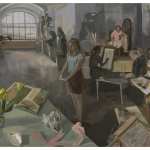
Contributed by Sharon Butler / Jane Swavely has lived and worked in a loft overlooking the Bowery since the 1980s when she was an SVA student and later a studio assistant to Brice Marden. Since “Jinx,” her pre-pandemic solo show at A.I.R. gallery, Jane’s work has become more subtractive, with looser brushwork, more gamsol and linseed oil, and lots of aggressive wiping out — erasing with big rags that she gets by the carton. She is fond of garish near-neon greens and vivid oranges and has introduced silver metallic paint that glimmers and changes depending on the light. Loose geometric shapes contrast with thin hard-edge lines — traces of the crossbar supports behind the canvas. Two of her paintings are on view in “Very Metal,” a witty group show at Theodore Gallery in Tribeca through March 11. Although she doesn?t like to talk about her work, Swavely invited me to stop by and see what she’s been up to.
Sharon Butler: Well, it looks like you’ve been making some moves since the last time I was here. These paintings are so loose. I love the metallic. What are you looking for in these new paintings? Where do you start?
Jane Swavely: I’d say I’m looking for a sort of luminosity that doesn’t necessarily translate to landscape. I’m trying to erase the landscape with minimal spatial representation I want to make non-representational objects with as little effort as possible. Thin paint. Not overworked. I want them to look super fresh. Sometimes they’re really fast, and then sometimes — like that one over there — they might take a couple of years. That one is my least favorite, because it just feels so labored. Where do I start? It’s more about stopping. I try to stop as soon as I can, when I feel like the painting has light and space and doesn’t seem predictable.
SB: Yes, the paintings have a sense of incompleteness. The erasure and scrubbiness give a sense that the work is in process, whereas that one you don’t like has definite lines and near-solid paint coverage. The process is additive and there is no subtraction or erasure.
JS: I don’t have a preconceived notion of what it’s about when I start. [Laughs] I think about what it’s about afterwards. When I’m making them I’m just interested in the materials and the way the paint behaves, the mixtures of colors, especially the silver paint, and I want to make them as minimal as possible. Subtraction is interesting. The paintings are stretched and primed usually by me (I learned how to stretch huge canvases working as a studio assistant throughout my 20s ) and painted flat on the floor. You can see the stretcher bars and the actual physical-ness of the painting and the materials. They’re slippery. If a painting looks like it’s almost unfinished, if I like the shapes and there are cool moments in it that I enjoy, then it’s done.
SB: Your work lends itself to working on huge canvases because it seems that the material struggle is what the painting is all about. The smaller ones are very different. They are tidier.
JS: Yeah, I love huge paintings. I wish I had the space to make even bigger paintings right now, but I don’t. I’m going to knock down some walls and reclaim my space out there [points out to the bedroom that her kids, now grown, occupied while they were young and her husband’s music room]. I love those humongous Clifford Styll paintings in the Met.
SB: What do you love about huge paintings?
JS: I like the physicality of them, the way you feel when you stand in front of them.
SB: That they tower over you?
JS: Yeah, and making something that large feels really powerful somehow, although they’re not very practical. I thought I was going to stop making big paintings, and then I thought, what the hell, who cares about practicality, I’m going to do it anyway. What I’m after calls for it. I just want to paint.


“Very Metal: Bill Albertini, John Chamberlain, Willem de Kooning, Don Porcaro, Bill Schwarz, Jane Swavely, Mia Westerlund Roosen, H.C. Westermann, Aaron Williams,” Theodore Gallery, 373 Broadway #F10, Tribeca, New York, NY.
About the author: Sharon Butler is a painter and the publisher of Two Coats of Paint.
Related posts:
A good long look, at Spencer Brownstone
Interview with Jane Swavely: Toxic glow
Jane Swavely: Admiration for the jungle














Let the paintings speak!